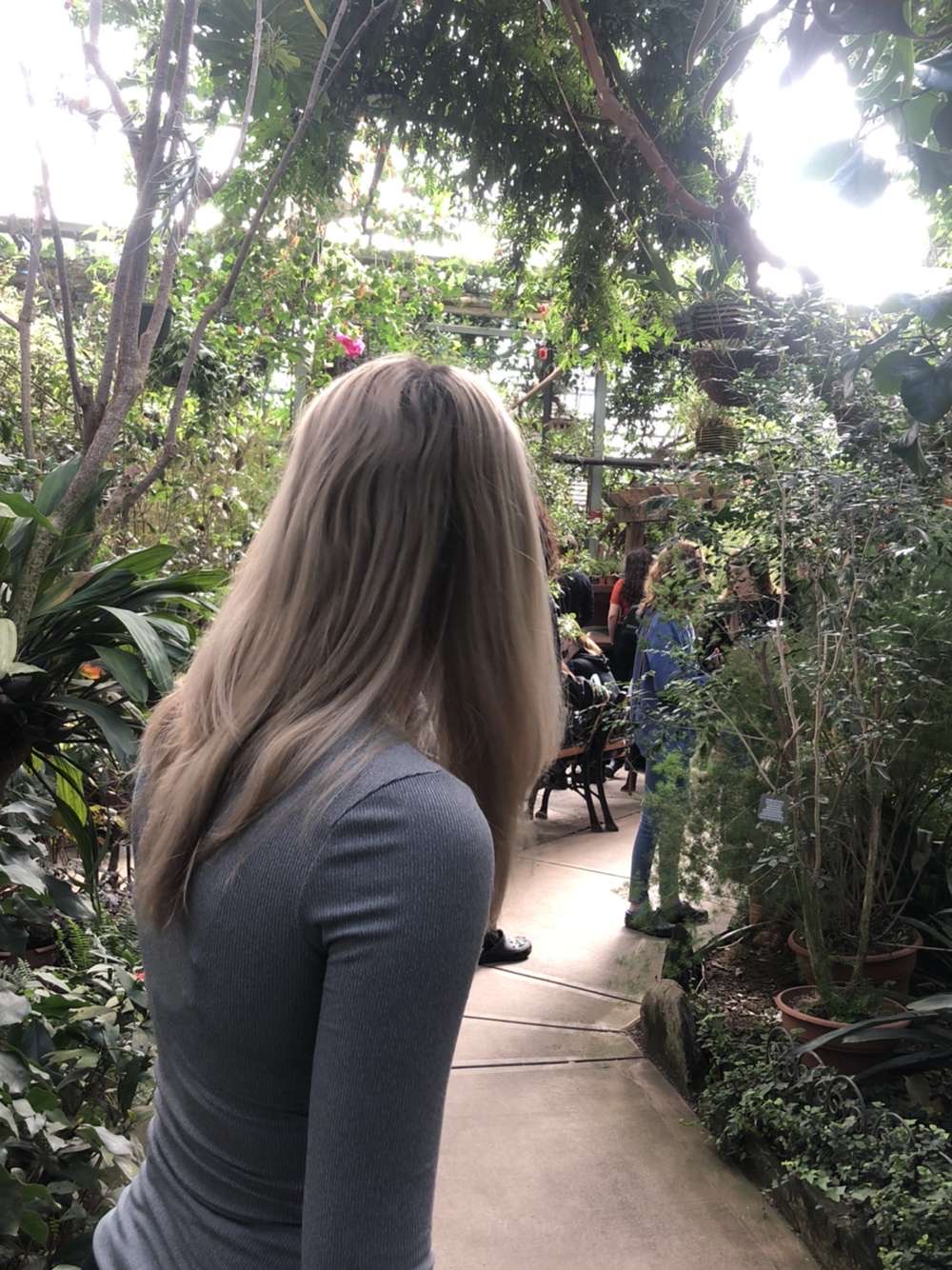Unraveling Womanhood: The Legacy of Louise Bourgeois
Embark on a profound journey into the heart of womanhood with Louise Bourgeois. “Unraveling Womanhood” unveils twelve masterpieces, each a testament to the complexities of feminine identity. From vulnerability to resilience, each artwork echoes the timeless struggles and triumphs of women. Join us as we delve into the rich tapestry of human experience, igniting conversations and celebrating the enduring spirit of womanhood.
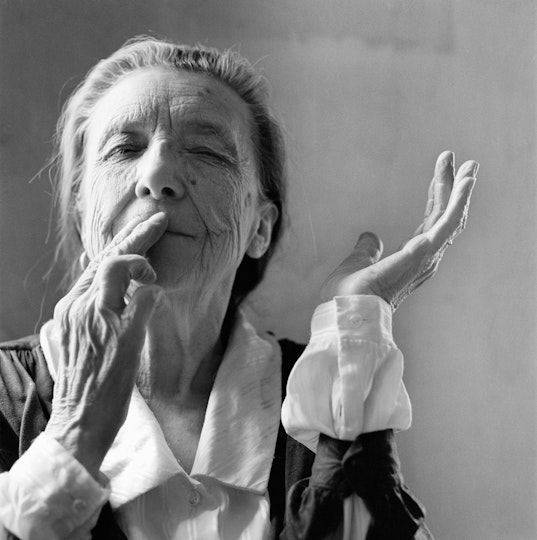
Welcome to Unraveling Womanhood: A Tribute to Louise Bourgeois
Bourgeois’ art serves as a mirror reflecting the diverse experiences, emotions, and struggles inherent in womanhood. From the tender vulnerability of Dismemberment to the abstract feelings of Bad Mother, each artwork embodies a spectrum of emotions and narratives that resonate deeply with the human experience.
In the first gallery, immerse yourself in the exploration of vulnerability and intimacy, where Bourgeois’ sculptures and installations evoke raw emotions and personal reflections. As you move through the exhibition, you’ll encounter themes of resilience, empowerment, and the reclaiming of agency in the face of societal expectations.
The second gallery delves into the complexities of motherhood, where Bourgeois’ pieces symbolize both nurturing and protective instincts intertwined with fear and anxiety. Here, you’ll witness the artist’s profound exploration of the maternal experience, challenging conventional notions of motherhood and familial relationships.
In the final gallery, confront the darker aspects of womanhood, as Bourgeois’ artworks confront issues of trauma, oppression, and the struggle for autonomy. Through powerful imagery and symbolism, the artist confronts the viewer with the harsh realities faced by women, sparking dialogue and fostering empathy.
“Unraveling Womanhood” invites you to engage with the timeless themes and narratives woven into Bourgeois’ art, encouraging reflection, dialogue, and a deeper understanding of the multifaceted nature of womanhood. Join us on this transformative journey as we celebrate the enduring spirit and resilience of women everywhere.

Resilience
In the realm of art, women’s voices have often been marginalized, mirroring the historical exclusion of women from sacred spaces. Yet, in Louise Bourgeois’ masterpieces, such as Trees with Shoes and Sainte Sébastienne, the resilience and power of womanhood shine through. Femme Maison challenges conventional notions of femininity and domesticity, while Woman-House offers a bold reimagining of women’s roles in society. Through these compelling works, Bourgeois invites us to contemplate the myriad facets of womanhood – from vulnerability to strength, from confinement to liberation. In each piece, the essence of womanhood is celebrated, reaffirming the importance of women’s voices and identities in the artistic landscape.

1998. Dry point and aquatint on paper | 39 x 28 1/16 inches. Whitney Museum of American Art Editions, New York
More Information
Louise Bourgeois’ Tree With Shoes, created in 1998, offers a profound exploration of the theme of resilience. This captivating piece, a dry point and aquatint on paper measuring 39 x 28 1/16 inches, is housed in the Whitney Museum of American Art Editions, New York. Through the juxtaposition of a natural element, the tree, with a seemingly incongruous object, the shoes, Bourgeois evokes a sense of resilience rooted in the human experience. The tree, a symbol of strength and endurance, stands tall amidst the presence of discarded shoes, suggesting the resilience found in the face of life’s trials and tribulations. The shoes, once worn and traveled, carry the stories of their wearers, embodying the resilience of the human spirit in the face of adversity. Bourgeois’ poignant portrayal prompts viewers to contemplate the resilience inherent in the human condition, acknowledging the capacity to endure and thrive despite challenges. Through Tree With Shoes, Bourgeois invites reflection on the resilience that sustains us through life’s journeys, emphasizing the enduring power of the human spirit to persevere and flourish.

1946-1947. Line block on textured, woven paper | 9 7/16 x 11 13/16 inches. The Museum of Modern Art, New York.
More Information
In Louise Bourgeois’ Femme Maison, created between 1946 and 1947, the theme of resilience is intricately woven into the fabric of the artwork. This line block on textured, woven paper, measuring 9 7/16 x 11 13/16 inches and housed at The Museum of Modern Art, New York, portrays the iconic image of a woman with a house as her head. Through this powerful imagery, Bourgeois explores the female psyche amidst the complexities of domesticity and identity. The juxtaposition of the female form with the architectural structure symbolizes the strength and adaptability of women in navigating the challenges of societal expectations and gender roles. Despite the confinement implied by the house, the woman retains her agency and pliability, emerging as a symbol of inner strength in the face of external pressures. Through Femme Maison, Bourgeois invites viewers to contemplate the resilience inherent in the female experience, celebrating the power of perseverance and self-determination.
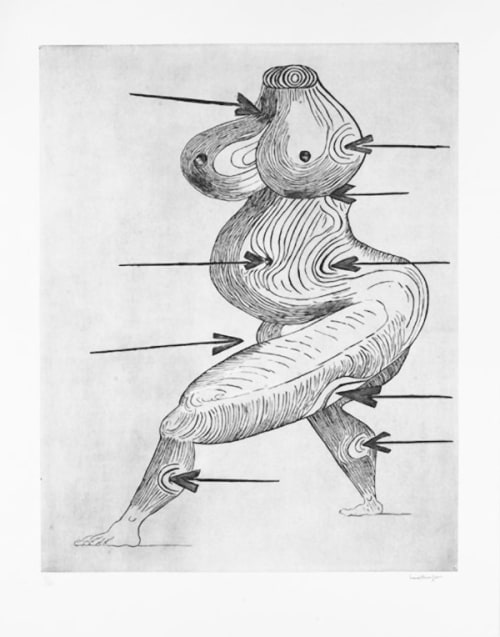
1992. Dry point on Somerset Satin paper | 47 x 37 inches. MCH Swiss Exhibition
More Information
In Louise Bourgeois’ Sainte Sébastienne, crafted in 1992, the theme of resilience takes center stage. This striking piece, a dry point on Somerset Satin paper measuring 47 x 37 inches, was showcased at the MCH Swiss Exhibition. Depicting the figure of Saint Sebastian, traditionally portrayed as a male martyr bound to a tree and pierced with arrows, Bourgeois subverts gender norms by presenting a female iteration of the saint. Through this transformation, she explores femininity in the face of adversity and persecution. The image of Sainte Sébastienne embodies strength, courage, and perseverance, symbolizing the resilience of women in overcoming physical and emotional trials. Bourgeois’ reinterpretation challenges traditional narratives of martyrdom, offering a poignant commentary on the resilience of the female spirit. Through Sainte Sébastienne, viewers are invited to reflect on the enduring power of resilience in the face of suffering and oppression, celebrating the indomitable spirit of women throughout history.
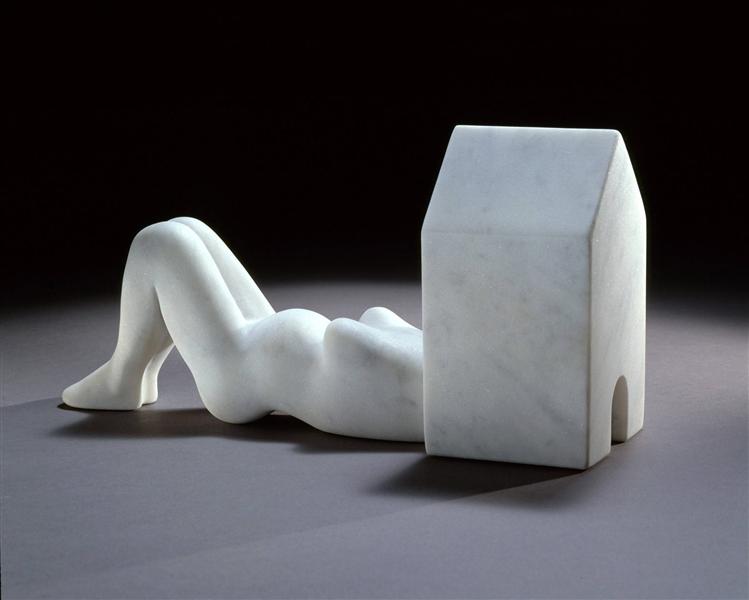
1994. White marble sculpture | 5 x 12 ½ x 2 ¾ inches. The Easton Foundation, DACS London.
More Information
In Louise Bourgeois’ Woman-House, sculpted in 1994 from white marble, where the head is enclosed in a house. This sculpture, measuring 5 x 12 ½ x 2 ¾ inches and housed at The Easton Foundation, DACS London, embodies the enduring strength and fortitude of the female spirit. Bourgeois intricately carves the marble to depict a symbolic representation of womanhood, evoking resilience in the face of adversity. The choice of marble, known for its durability and timelessness, underscores the enduring nature of toughness. Through Woman-House, Bourgeois emphasizes the capacity to withstand challenges and emerge with newfound strength.
Motherhood
In the realm of motherhood, societal norms have often cast a shadow on women’s experience. Louise Bourgeois’ artworks, such as The Bad Mother and The Reticent Child, vividly depict the complexities and challenges faced by mothers. Do Not Abandon Me echoes the universal plea for support amidst the trials of motherhood, while Pregnant Woman captures the transformative journey of impending motherhood. Through Bourgeois’ evocative representations, the intimate struggles and bonds of motherhood are laid bare, offering a profound reflection on the multifaceted nature of this sacred role in women’s lives.
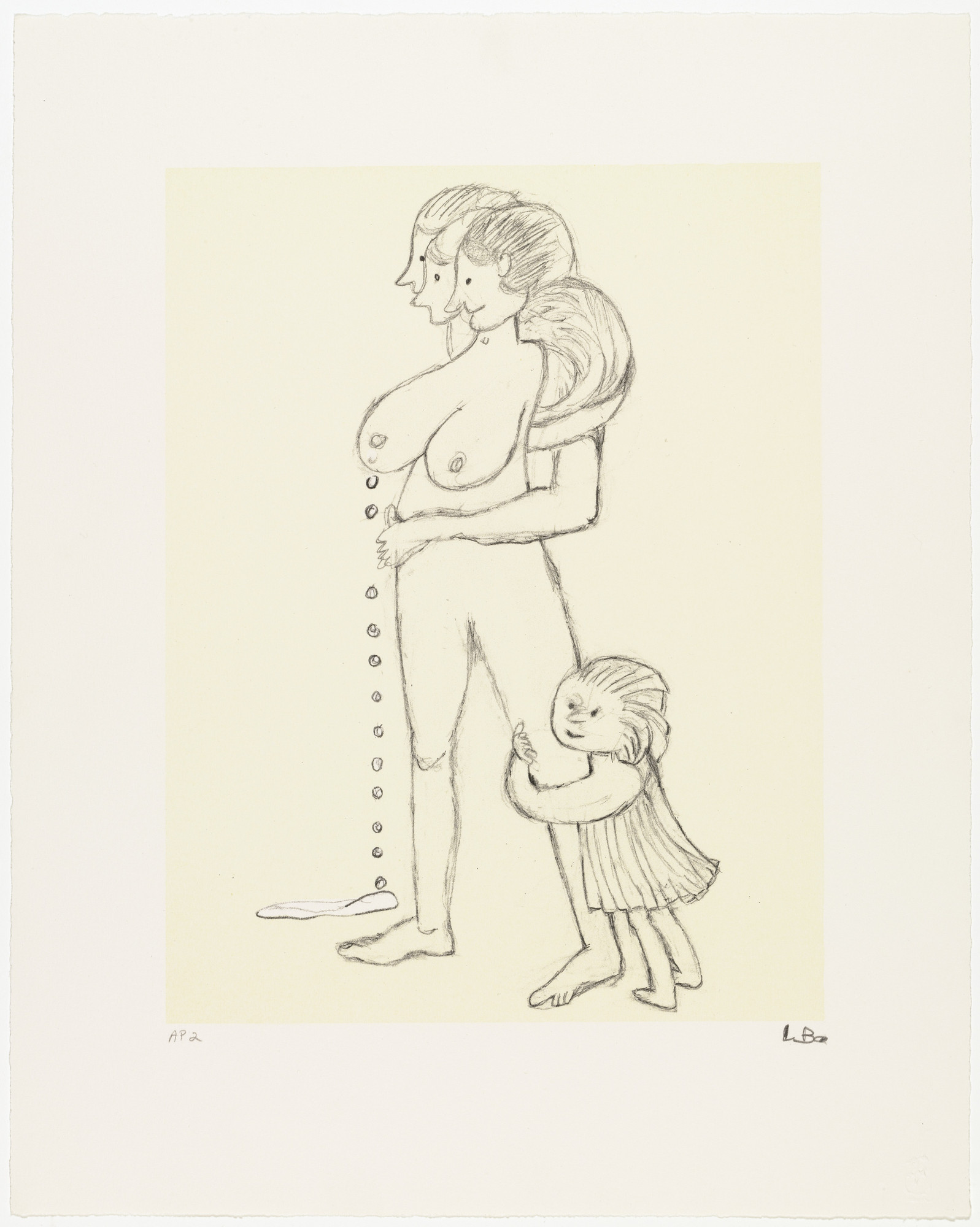
1998. Lithograph | 16 1/16 x 12 13/16 inches. The Easton Foundation/VAGA at ARS, NY
More Information
In Louise Bourgeois’ The Bad Mother, created in 1998, the theme of motherhood is explored with striking honesty and emotional intensity. This lithograph, measuring 16 1/16 x 12 13/16 inches, is housed at The Easton Foundation/VAGA at ARS, NY. Bourgeois delves into the complexities of the maternal role, challenging conventional notions of motherhood. Through her expressive technique, she confronts societal taboos and personal struggles associated with the archetype of The Bad Mother. The artwork invites viewers to contemplate the nuances of guilt, imperfection, and societal expectations placed upon mothers. With bold strokes and profound symbolism, Bourgeois prompts introspection and empathy, urging us to reconsider our perceptions of motherhood and the complexities that lie within.

2004. Dry point with hand additions, on three sheets | Plate (a) 11 ½ x 9 inches. Plate (b) 9 x 11 ½ inches. Plate © 11 ½ x 9 inches. The Museum of Modern Art, Manhattan.
More Information
The Reticent Child, created by Louise Bourgeois in 2004, delves into the theme of motherhood through its intricate composition. This artwork, crafted using dry point with hand additions on three separate sheets, explores the complexities of the maternal bond. Through Bourgeois’ masterful technique, viewers are drawn into a contemplative exploration of the relationship between mother and child. Housed at The Museum of Modern Art in Manhattan, this piece serves as a poignant reflection on the silent emotions and unspoken connections within the realm of motherhood.
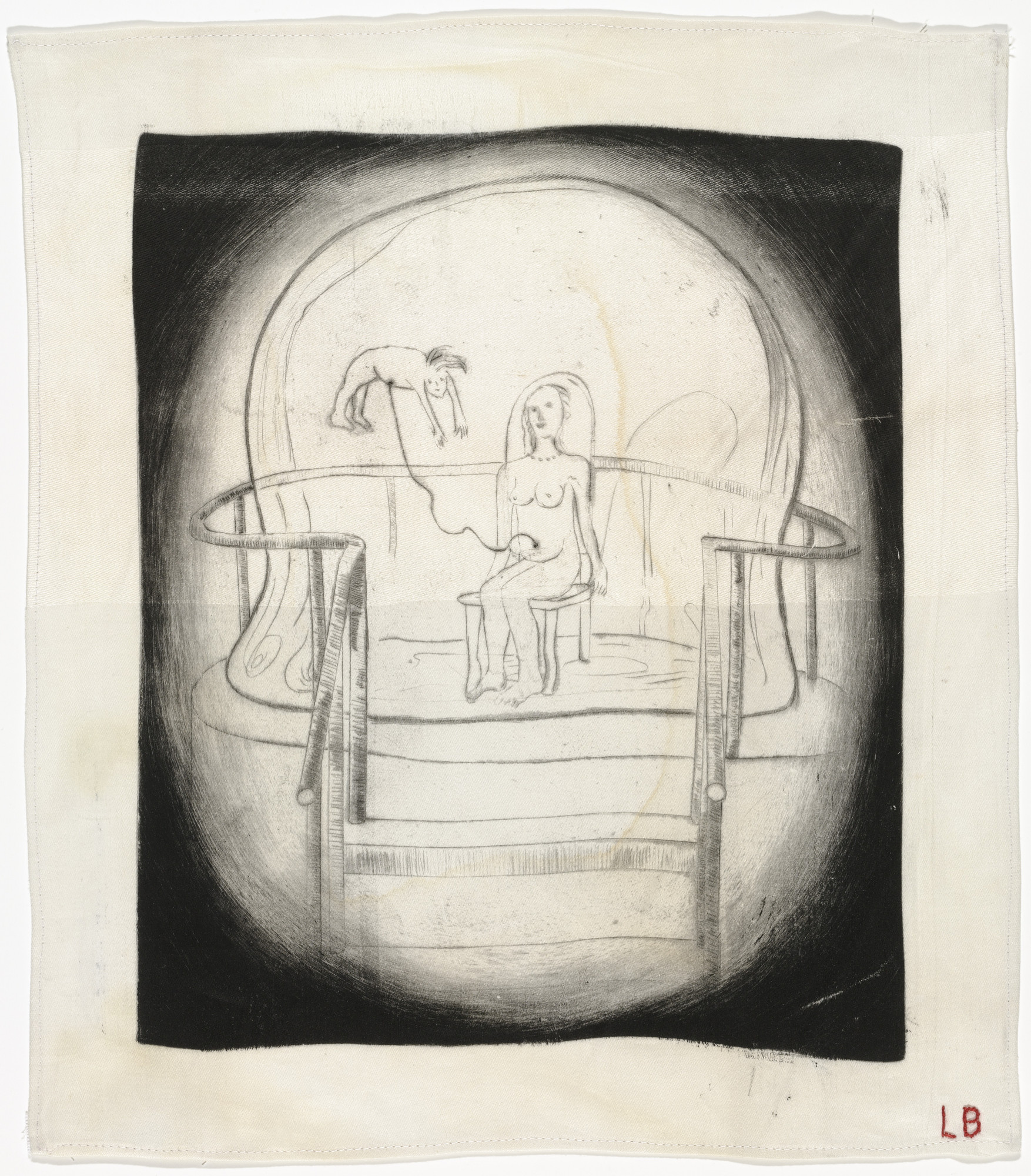
2000. Dry point on paper | 14 9/16 x 12 15/16 inches. The Modern Museum of Art, New York
More Information
Louise Bourgeois’ Do Not Abandon Me, completed in 2000, portrays the theme of motherhood with profound depth. Executed through dry point on paper, this artwork measures 14 9/16 x 12 15/16 inches and is housed at The Modern Museum of Art in New York. Through her evocative technique, Bourgeois captures the vulnerability and plea inherent in the maternal relationship. The title itself echoes the universal sentiment of dependence and longing, inviting viewers to contemplate the complexities of maternal love and the fear of separation. With subtle yet poignant symbolism, Bourgeois confronts the viewer with the raw emotions of motherhood, urging empathy and reflection.

2007. Gouache on paper | 23 1/2 x 18 inches. The Easton Foundation, New York and London.
More Information
Through Bourgeois’ unique artistic lens, this piece explores the theme of motherhood and femininity, offering viewers a glimpse into the complexities of these experiences. The use of gouache lends a sense of depth and texture to the work, while Bourgeois’ expressive strokes evoke a range of emotions. Housed at The Easton Foundation in New York and London, Pregnant Woman stands as a testament to Bourgeois’ ability to capture the essence of human existence through her art.
Struggle For Autonomy
Throughout history, women have encountered barriers to autonomy and rights to their own bodies. Louise Bourgeois’ artworks, such as Dismemberment and Spiral Woman, vividly portray the internal struggle for autonomy amidst external constraints. While women were being denied certain spaces, their bodies marginalized, their artistic expressions, like Topiary, flourished as symbols of resilience. Bourgeois’ Stay Out of My Hair resonates with the defiance of women against societal limitations, serving as a call for autonomy. Despite facing restrictions, women persistently carved out their presence, with their artworks serving as powerful means of expression and assertion of autonomy.

1994. Dry point and roulette | 21 1/8 x 14 11/16 inches. The Easton Foundation/VAGA at ARS, New York.
More Information
Louise Bourgeois’ Dismemberment, crafted in 1994, delves into the theme of the struggle for autonomy. This artwork, executed using dry point and roulette techniques, measures 21 1/8 x 14 11/16 inches and is housed at The Easton Foundation/VAGA at ARS, New York. Bourgeois masterfully portrays the complexities of asserting one’s identity amidst societal pressures and personal challenges. The title itself evokes notions of fragmentation and disintegration, reflecting the internal conflict inherent in the pursuit of autonomy. Through the intricate lines and textures created by the dry point and roulette methods, Bourgeois invites viewers to confront the fragmented nature of the self and the relentless struggle to reconcile disparate aspects of one’s identity. In Dismemberment, Bourgeois offers a poignant exploration of the tumultuous journey toward self-realization and independence.

2005. Dry point, with blue ink and white correction fluid additions on paper | 15 ½ × 11 ¼ inches. The Museum of Modern Art, Manhattan, CT
More Information
In Louise Bourgeois’ Topiary, crafted in 2005, the theme of the struggle for autonomy in womanhood is poignantly explored. This dry point artwork, embellished with blue ink and white correction fluid on paper, measures 15 ½ × 11 ¼ inches and is showcased at The Museum of Modern Art, Manhattan, CT. Through intricate lines and delicate alterations, Bourgeois delves into the complexities of female identity and the quest for self-definition. The metaphor of the topiary, with its controlled shaping of nature, serves as a powerful symbol of societal expectations and the pressure to conform. Bourgeois invites viewers to contemplate the tension between external influences and inner autonomy, prompting reflection on the challenges faced by women in asserting their individuality within a structured world.

2002. Dry point with select engraving, fabric | 21 ¾ x 14 ½ inches. The Museum of Modern Art, New York.
More Information
In Louise Bourgeois’ Spiral Woman, completed in 2002, the theme of the struggle for autonomy resonates deeply. This artwork, a dry point with select engraving and fabric additions, measures 21 ¾ x 14 ½ inches and is housed at The Museum of Modern Art, New York. Bourgeois intricately weaves her exploration of female identity and agency into the spiral motif, symbolizing the journey of self-discovery and empowerment. The incorporation of fabric adds tactile depth, inviting viewers to engage with the artwork on a visceral level. Through her nuanced depiction of the female form within the spiral, Bourgeois prompts contemplation of the cyclical nature of personal growth and the perpetual quest for autonomy in a world fraught with constraints.
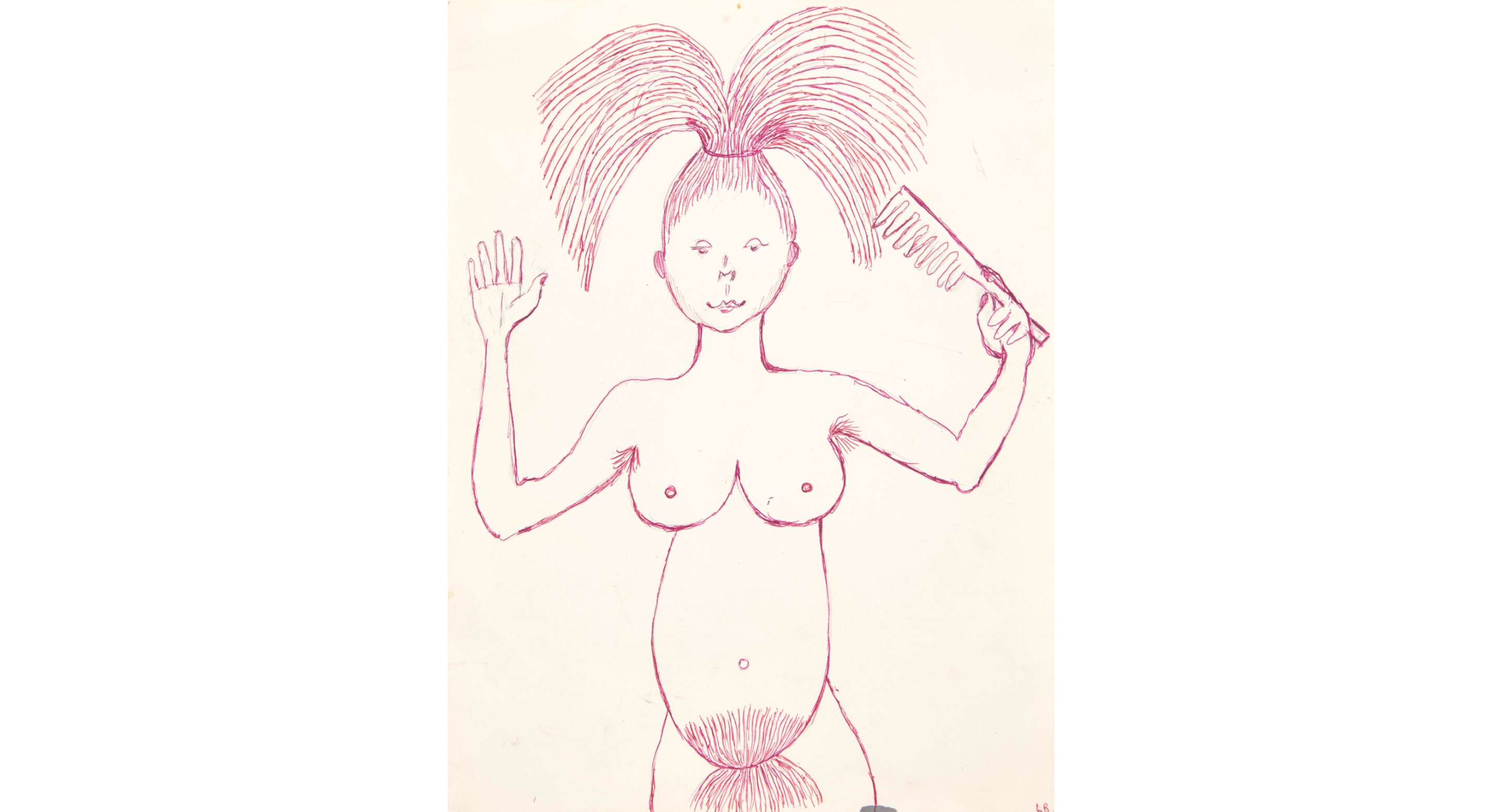
1997. Ink and pencil on paper | 12 x 9 in. Museum of Modern Art, Manhattan.
More Information
Stay Out of My Hair (1997) is an enigmatic drawing that resonates with themes of boundaries and autonomy. Through its title and form, Bourgeois prompts reflection on the complexities of personal space and independence. The work invites viewers to contemplate their own relationships and desires for privacy, while also embodying the artist’s signature exploration of the human psyche and emotional landscapes.
Final Thoughts
Before you go, take one last glance at the art around you. Pause and ponder: “Why are so many of these women depicted without heads?” It’s a question that speaks volumes about representation, identity, and the narratives we choose to tell. In this sense, I believe the artist is displaying the objectification and dehumanization women and herself face. What do you think?
Thank You For Coming
As this thought-provoking art exhibition comes to a close, consider how Louise Bourgeois’s creations weave a powerful narrative about the essence of women. Every work takes us into a world where motherhood, resiliency, and the desire for autonomy blend to create a complex tapestry of feminine experience. Bourgeois explores the depths of human emotion via her art, provoking us to consider the intricacies of personal limits and the perseverance needed to stand up for independence. The themes of motherhood have a soft, poignant resonance that acknowledges and celebrates the challenges of raising a healthy child. Concurrently, the investigation of femininity poses challenges to established norms, encouraging contemplation on the many attributes of being a woman. We are reminded of women’s steadfast quest for selfhood and empowerment and their resilience in the face of adversity, as we stand among these poignant displays. In addition to acting as a mirror reflecting the realities of women, Bourgeois’s artwork also acts as a beacon pointing the way toward a more profound comprehension of the human condition. Before you depart, please enjoy the video below of the artist discussing what inspires her work.
Louise Bourgeois said in an interview, “Feminists have adopted me as a model, as a mother, which irritates me. I am not interested in being their mother. This really annoys me. This is not the point. I am still a young girl trying to understand herself, not a mother. I was a real mother, and I took care of my children. This wasn’t a problem for me (Nadotti, 2019).”
Alivia Dyson
Women & Art Spring 2024
Immerse yourself and become your best self.
Works Cited
Bourgeois, Louise. Dismemberment. 1994, The Easton Foundation/VAGA at ARS, New York. https://www.moma.org/collection/works/84201
Bourgeois, Louise. Do Not Abandon Me. 2000, The Museum of Modern Art, New York. https://www.moma.org/collection/works/76848
Bourgeois, Louise. Femme Maison. 1946-1947, The Museum of Modern Art, New York. https://www.moma.org/s/lb/collection_lb/compositions/compositions_id-4358_sov_image-1.html
Bourgeois, Louise. Maman (Ama), 1999. The Guggenheim Museum and Foundation, New York. https://www.guggenheim.org/artwork/10856
Bourgeois, Louise. Pregnant Woman. 2007, The Easton Foundation, New York and London. https://ocula.com/art-galleries/hauser-wirth/artworks/louise-bourgeois/pregnant-woman/ 567
Bourgeois, Louise. Sainte Sébastienne. 1992, MCH Swiss Exhibit. https://www.artbasel.com/catalog/artwork/43387/Louise-Bourgeois-Sainte-Sebastienne?lang=en
Bourgeois, Louise. Spiral Woman. 2002, The Museum of Modern Art, New York. https://www.moma.org/s/lb/collection_lb/allworks/allworks_sov_page-2747.html
Bourgeois, Louise. Stay Out of My Hair. 1997, The Museum of Modern Art, Manhattan. https://www.artsy.net/artwork/louise-bourgeois-stay-out-of-my-hair
Bourgeois, Louise. The Bad Mother. 1998, The Easton Foundation/VAGA at ARS, New York. https://www.moma.org/collection/works/62391
Bourgeois, Louise. The Reticent Child, 2004, The Museum of Modern Art, Manhattan. https://www.moma.org/collection/works/150557
Bourgeois, Louise. Topiary, 2005, The Museum of Modern Art, Manhattan. https://www.moma.org/collection/works/113318
Bourgeois, Louise. Tree With Shoes. 1998, Whitney Museum of American Art Editions, NewYork.https://www.moma.org/s/lb/collection_lb/ppbyid/ppbyid_ppid-20694_role-4_thumbs.html
Bourgeois, Louise. Woman-House. 1994, The Easton Foundation, DACS London. https://www.architectural-review.com/essays/reputations/louise-bourgeois-1911-2010
“Louise Bourgeois Drawings 1947 – 2007.” YouTube, Hauser& Wirth Art Gallery, 25 Mar. 2020, youtu.be/RFvY5E3eESI?si=LhcX9cm9loaB_6Ve.
Nadotti M. La distruzione del padre: An Interview with Louise Bourgeois. Salmagundi, [s. l.], n. 202/203, p. 150–165, 2019. Disponível em: https://research.ebsco.com/c/jt3u4x/viewer/pdf/ykyv7vfwkf Nixon, M. Losing Louise. October, [s. l.], n. 134, p. 122–132, 2010. DOI 10.1162/OCTO_a_00015. Disponível em: https://research.ebsco.com/c/jt3u4x/viewer/pdf/eu5l2223an
Join 900+ subscribers
For website support, please contact @admin
